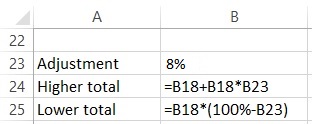

- #Technical formula for average of percentages how to
- #Technical formula for average of percentages manual
- #Technical formula for average of percentages series
The arguments can be supplied as numbers, references, or named ranges.ĪVERAGE is one of the most straightforward and easy-to-use functions in Excel. Up to 255 arguments can be included in a single formula. Where number1, number2, … are numeric values for which you want to find the average. In Excel, this can be done using the SUM and COUNT functions, respectively: In math, to find the arithmetic mean of a list of numbers, you need to add up all the values, and then divide the sum by how many numbers there are in the list. One of the values that Excel calculates automatically is the average. Look at the status bar at the bottom of the Excel window, which provides the essential information about the currently selected cells.For non-contiguous selections, use the Ctrl key. Select the cells or ranges you want to average.To quickly find an average without a formula, use Excel's status bar: Before exploring the specialized functions in detail, let's learn a quick and amazingly simple non-formula way.
#Technical formula for average of percentages manual
In Excel worksheets, you do not need to perform manual calculations - powerful Excel functions will do all the work behind the scenes and deliver the result in no time.
#Technical formula for average of percentages how to
How to get average in Excel without formulas In the above example, assuming the first athlete covered the distance in 10.5 seconds, the second needed 10.7 seconds, and the third took 11.2 seconds, the average time would be 10.8 seconds: In mathematics, the average is the middle or central value in a set of numbers, which is calculated by dividing the sum of all the values by their number. how much time most sprinters are expected to take to complete the race. For example, if a few athletes have run a 100m sprint, you may want to know the average result - i.e.
#Technical formula for average of percentages series
Whenever you have time series kind of data expressed as percentages (which is very common in finance and investing), arithmetic average is misleading. When investing, dollars or euros matter more than percentages in the end. Geometric average is better for averaging performance over time 50% of 1.7 million is greater than 70% of 1 million, though it doesn't seem so looking at the percentages only. When you have stock performance expressed in percent, the percentage advance or decline in every particular year is measured relative to the stock's price at the beginning of that year – which is different for each year. In the second year, its value has halved, and you end up at 0.85 million – less than what you've invested. How much money have you made in reality? If you have invested a million dollars, at the end of year 1 your position was worth 1.7 million. What is the arithmetic average of the stock's return? The sum of +70% and -50% is +20%, divided by 2 gives us +10%. Your stock performed like this in the last two years: Stock investment example with arithmetic average Relative Strength Index (RSI) Calculator.Calculating Variance and Standard Deviation in 4 Easy Steps.Why You Need Weighted Average for Calculating Total Portfolio Return.Why Arithmetic Average Fails to Measure Average Percentage Return over Time.Arithmetic Average: When to Use It and When Not.Arithmetic Average Advantages and Disadvantages.


You are in Tutorials and Reference» Statistics for Finance


 0 kommentar(er)
0 kommentar(er)
